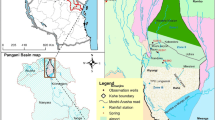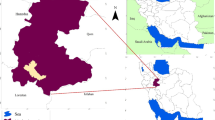Abstract
Gaza Strip is experiencing a severe water crisis caused mainly by overexploitation of the groundwater source. Rainfall is the only source of freshwater replenishment for the Gaza coastal aquifer. Groundwater level has dropped to more than 10 m below mean sea level as a result of aquifer exploitation and imbalance between recharge and abstraction in the past decades, which exposes the groundwater to seawater intrusion. As the only fresh water source recharging the aquifer is from rainfall, it is essential to estimate the annual recharge volume from rainfall. This paper is focusing on recharge estimation based on historical daily rainfall data for the past 41 years (1973–2014). An estimation of surface runoff was made using soil conservation services curve number method. An estimation of groundwater recharge has been calculated using two different methods: Thornthwaite and Mather soil moisture balance approach and chloride mass balance. Four land use maps and data have been used for the entire calculation period, three of them based on actual surveys carried out in 1994, 2004 and 2010, while the fourth map was developed based on the population expansion trend to cover the period before 1993. It was found that the proportion of built-up area has expanded from 8.25% in 1982 to 25.23% in 2010, while the sand dune area has shrunk from 31.46% in 1982 to 8.64% in 2010. Runoff has doubled from 6.9 million m3 in 1982 to 13.7 million m3 in 2010, while groundwater recharge was reduced from 24.4 million m3 in 1982 to 18.1 million m3 in 2010.











Similar content being viewed by others
References
Aish A, Batelaan O, De Smedt F (2010) Distributed recharge estimation for groundwater modeling using WETPASS model, case study—Gaza Strip. Palestine Arab J Sci Eng 35(1B):155–163
Aliewi A, Mackay R, Jayyousi A, Nasere K, Mushtaha A, Yaqubi A (2001) Numerical simulation of the movement of saltwater under skimming and scavenger pumping in the Pleistocene Aquifer of Gaza and Jericho Areas, Palestine. Transp Porous Media 43:195–212
Baalousha (2005) Using CRD method for quantification of groundwater recharge in the Gaza Strip, Palestine. Environ Geol 48:889–900. https://doi.org/10.1007/s00254-005-0027-x
Baalousha H (2012) Comment on “distributed recharge estimation for groundwater modelling using WETSPAA model—Gaza Strip, Palestine” by Adnan M. Aish, O. Batelaan, F. De Smedt, December 2012, Volume 37, Issue 8, pp 2175–2177. Arab J Sci Eng. https://doi.org/10.1007/s13369-012-0323-1
Bakundukize C, Van Camp M, Walraevens K (2011) Estimation of groundwater recharge in Bugesera Region (Burundi) using soil moisture budget approach. Geol Belgica 14(1–2):85–102
Chow V, Maidment D, Mays L (2002) Applied hydrology. McGraw-Hill Book Company, New York
CIA World Factbook (2014) Gaza Strip population. Excludes Israeli settlers, but includes estimated 225 k Non-Israeli Palestinians in East Jerusalem
CMWU (2013) Water resource status in the Gaza Strip. CMWU, Gaza
Eriksson E, Khunakasem V (1969) Chloride concentrations in groundwater, recharge rate and rate of deposition of chloride in the Israel coastal plain. J Hydrol 7:178–179
FAO (2012) AquaCrop—reference Manual. Land and Water Division, Rome
Goris K, Samian M (2001) Sustainable Irrigation in the Gaza Strip. M.Sc Thesis, KU Leuven
Greitzer Y, Dan J (1967) The effect of soil landscape and quaternary geology on the distribution of saline and fresh water aquifers in the Coastal Plain of Israel. Tahal Water Planning for Israel, Ltd, Tel Aviv
Hamad J, Eshtawi T, Abushaban A, Habboub M (2012) Modeling the impact of land-use change on water budget of Gaza Strip. J Water Resour Protect. https://doi.org/10.4236/jwarp.2012.46036
Hamdan MS, Troeger U, Nassar A (2007) Stormwater availability in the Gaza Strip, Palestine. Int J Environ Health 1:4
Hamdan S, Troeger U, Nassar A (2011) Quality risks of stormwater harvesting in Gaza. https://doi.org/10.3923/jest.2011.55.64
IWACO, WRAP (1995) Groundwater resources assessment of the Gaza Strip, Technical report, IWACO Euroconsult and Water Resources Action Program (WRAP)
Kiely G (1996) Environmental Engineering, Mulvancy 1851, Kuichling 1889 and Lloyd-Davis 1906 in Kiely G (Ed.). McGraw-Hill, Boston, pp 187–199 (ISBN 0-07-116424-3)
Liu YB, De Smedt F (2004) WetSpa extension, a GIS-based hydrologic model for flood prediction and watershed management-documentation and user manual. Department of Hydrology and Hydraulic Engineering, Vrije Universiteit Brussel, Belgium
Melesse A, Graham W, Jordan J (2003) Spatially distributed watershed mapping and modeling GIS-based storm runoff response and hydrograph analysis: Part 2. J Spat Hydrol 3:2
Melloul A, Bachmat Y (1975) Evaluation of hydrological situation as a basis for operational management of the Coastal Plain aquifer of the Gaza Strip, Report 50 pp, Hydrological Service of Israel, (in Hebrew)
Moe H, Hossain R, Fitzgerald R, Banna M, Mushtaha A, Yaqubi A (2001) Application of a 3-dimensional coupled flow and transport model in the Gaza Strip, First international conference on saltwater intrusion and coastal aquifers—monitoring, modeling, and management, Essaouira, Morocco, April 23–25
MOPIC (1995) Groundwater resources assessment of the Gaza Strip, Interim Report. MPOIC, Gaza Strip
Mushtaha A (1999) Control of saltwater upcoming by using scavenger pumping well. IHE-Delft, Delft
Mushtaha A, Aliewi A, Mackay R (2000) The use of Scavenger wells to control saltwater upcoming in Gaza, Palestine. In: Proceedings 16th salt water intrusion meeting, Miedzyzdroje–Wolin Island, Poland, pp 109–116
PCBS (2017) Statistical Year book of Palestine, Palestinian Central Bureau of Statistics
PWA (1999) Water sector strategic planning study (WSSPS). PWA, Gaza
PWA (2017) Water resources status summary report/Gaza Strip. 2017. Water Resources Directorate
PWA/USAID (2000) Integrated aquifer management plan. PWA, Gaza
Ritter ME (2006) The physical environment: an introduction to physical geography. http://www.earthonlinemedia.com/ebooks/tpe_3e/title_page.html
SCS (1985) National engineering handbook (Sect. 4). US Dept. of Agriculture, Soil Conservation Service, Washington, DC
US Army Corps of Engineers’ Hydrologic Engineering Center (2009) User manual V4.2, HEC-GeoHMS geospatial hydrologic modeling extension US, hydrologic engineering center. http://www.hec.usace.army.mil/software/hec-geohms/documentation/HEC-GeoHMS_Users_Manual_4.2.pdf
USDA (2009) Hydrology national engineering handbook (Chap. 7). United States Department of Agriculture (Natural Resources Conservation Service), New York
USDA-SCS (1986) Urban hydrology for small watersheds, Technical Release 55 (TR-55). Soil Conservation Service
Vengosh A, Rosenthal E (1994) Saline groundwater in Israel its bearing on the water crisis in the country
Vengosh A, Spivack AJ, Artzi Y, Ayalon A (1999) Geochemical and boron, strontium, and oxygen isotopic constraints on origin of the salinity in groundwater from the Mediterranean Coast of Israel
Walraevens K, Vandecasteele I, Martens K, Nyssen J, Moeyersons J, Gebreyohannes T, De Smedt F, Poesen J, Deckers J, Van Camp M (2009) Groundwater recharge and flow in a small mountain catchment in the Tigray region in North Ethiopia. Hydrol Sci J 54(4):739–753. https://doi.org/10.1623/hysj.54.4.739
WRAP (1994) Palestinian Water Resources, a rapid interdisciplinary sector review and issues paper, Jerusalem
Acknowledgements
The authors want to thank the anonymous reviewer, whose comments have guided us to strongly improve the manuscript.
Author information
Authors and Affiliations
Corresponding author
Additional information
Publisher’s Note
Springer Nature remains neutral with regard to jurisdictional claims in published maps and institutional affiliations.
Electronic supplementary material
Below is the link to the electronic supplementary material.
Rights and permissions
About this article
Cite this article
M. Mushtaha, A., Van Camp, M. & Walraevens, K. Evolution of runoff and groundwater recharge in the Gaza Strip over the last four decades. Environ Earth Sci 78, 32 (2019). https://doi.org/10.1007/s12665-018-7999-9
Received:
Accepted:
Published:
DOI: https://doi.org/10.1007/s12665-018-7999-9




